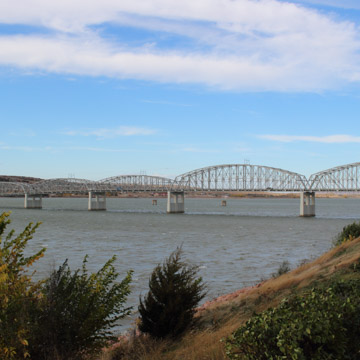You are here
American Legion Memorial Bridge
What is now known as the American Legion Memorial Bridge spans the Missouri River and Lake Francis Case between the towns of Chamberlain and Oacoma in Brule County, South Dakota.
Originally called the Chamberlain Bridge, the first portion was constructed in 1925. The steel bridge comprised four 336-foot, riveted Pennsylvania through-truss spans. The bridge was fabricated and erected by Missouri River Bridge and Iron Works of Leavenworth, Kansas, and dedicated on September 25, 1925. The through-truss bridge provided a narrow, two-lane deck suitable for traffic in the 1920s and 1930s. By 1950, however, traffic had increased and the bridge was no longer adequate. There were no funds for replacement and, furthermore, with the construction of Fort Randall Dam (1946–1953) and the subsequent widening of the river at Chamberlain and formation of Lake Francis Case, the existing bridge was not long enough to span the new lake. To address the problem, plans were developed to move the bridge one-quarter mile south, lengthen it, and add a parallel twin span.
Rather than build a new structure for the parallel twin span, state engineers decided to relocate Wheeler Bridge from seventy miles downstream. Also built in 1925, Wheeler Bridge comprises six 256-foot, pin-connected Pennsylvania through-truss spans. The steel bridge was fabricated by the American Bridge Company and erected by the Kansas City Bridge Company. When construction on Gavins Point Dam began in 1952 at the South Dakota–Nebraska border, Wheeler Bridge would have been submerged in the resulting Lewis and Clark Lake. Instead, it was disassembled, floated upstream, and reassembled to form the twin span of the new Chamberlain-Oacoma Bridge, which opened on December 7, 1953.
Both structures were designed by South Dakota’s first state bridge engineer, John Edward Kirkham. In 1923, he secured legislative funding for five Missouri River bridges, including the Chamberlain and Wheeler bridges. He is credited with bringing a new age of transportation to the state.
When I-90 was constructed in the 1970s, the Chamberlain-Oacoma Bridge did not meet bridge standards for interstate highways, resulting in the construction of a new four-lane bridge further south. The old two-lane bridge continued to carry the designation of U.S. 16, until that highway was decommissioned in 1979, at which time the Chamberlain-Oacoma Bridge became the I-90 Business Loop. The structure was rehabilitated in 2010 and renamed in honor of the South Dakota American Legion in 2014.
References
Writing Credits
If SAH Archipedia has been useful to you, please consider supporting it.
SAH Archipedia tells the story of the United States through its buildings, landscapes, and cities. This freely available resource empowers the public with authoritative knowledge that deepens their understanding and appreciation of the built environment. But the Society of Architectural Historians, which created SAH Archipedia with University of Virginia Press, needs your support to maintain the high-caliber research, writing, photography, cartography, editing, design, and programming that make SAH Archipedia a trusted online resource available to all who value the history of place, heritage tourism, and learning.

